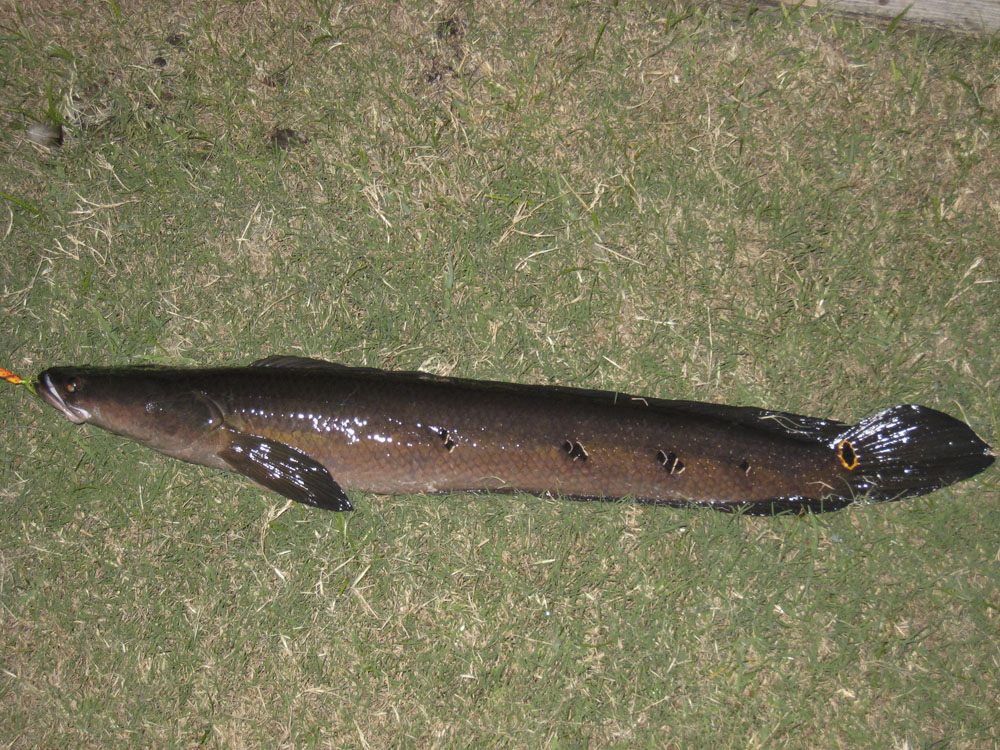
Channa marulius
FAMILY
Channidae
TAXONOMY
Ophiocephalus marulius Hamilton, 1822, ponds and freshwater
rivers of Bengal.
OTHER COMMON NAMES
English: Great snakehead; Thai: Pla chon ngu hao, pla kalon;
Burmese: Nga yan dyne; Laotian: Pa gooan; Khmer: Trey
raws; Bengali (West Bengal): Sal, gajal; Sinhalese: Ara.
PHYSICAL CHARACTERISTICS
Among the largest of snakeheads (48 in or 122 cm maximum
length). It has 4–6 large round black blotches on the body; some
populations have white margins and small white spots on these
blotches. Also has a white or orange-rimmed ocellus on the upper
portion of the caudal fin base (sometimes absent or indistinct
in indiviuals over 300 mm SL), moderately large scales
(LL=52–70), and no scales on the underside of the lower jaw.
Also, young may have an orange longitudinal band running
from the tip of the head to the caudal fin that fades as the fish
matures.
DISTRIBUTION
Widely distributed in tropical Asia from the Indus River basin
of Pakistan and the whole Indian subcontinent, including Sri
Lanka, through Myanmar and Indochina. Also introduced and
established in Florida, United States.
HABITAT
Large rivers, lakes, and reservoirs; prefers clear stretches of water
with a sandy and rocky bottom.
FEEDING ECOLOGY AND DIET
Known to feed mainly on fishes. It probably also eats other
vertebrates and invertebrates such as frogs and crustaceans.
BEHAVIOR
The species is capable of terrestrial movement.
REPRODUCTIVE BIOLOGY
In West Bengal this species spawns from April to June. Parents
use their mouths to cut elaborate passages through the weeds
leading to the floating bubble nest, where 2,000–40,000 light
red-yellow eggs (0.08 in [2 mm] in diameter) hatch in about 54
hours. The pair also guards the fry.
CONSERVATION STATUS
Not threatened.
SIGNIFICANCE TO HUMANS
Readily seen as a food fish in India and some parts of Southeast
Asia. A number of interesting local beliefs are attributed to
this fish. In central Thailand, the common name means “cobra
snakehead” and comes from the superstition that its bite is very
poisonous, leading to death. In Myanmar, the Karen people
regard it with awe and avoid eating it, practices that arise out
the belief that these fish were formerly humans who were
changed into fish for their sins, as well as the belief that if a
person eats one, he or she will be transformed into a lion.
Giant snakehead||
Channa micropeltes
FAMILY
Channidae
TAXONOMY
Ophicephalus micropeltes Cuvier in Cuvier and Valenciennes,
1831, Java.
OTHER COMMON NAMES
English: Red snakehead; Khmer: Trey chhdaur; Laotian: Pa
do; Malay: Ikan toman: Thai: Pla chado; Vietnamese: Cб bong.
PHYSICAL CHARACTERISTICS
Length 51.2 in (130 cm); one of the largest snakeheads. Has
very small scales (LL=83–106); patch of small scales near
underside tip of lower jaw; large canine-like teeth on upper
and lower jaws. Juveniles have vivid black horizontal stripe
above and below a bright orange to red stripe running head
to tail. Coloration fades into bluish black and white dappled
upper body in adults.
DISTRIBUTION
Widely distributed in Southeast Asia (excluding Myanmar and
northern Vietnam) and coastal region of southwestern India.
HABITAT
Large, slow-running to stagnant waters in open country.
BEHAVIOR
The most aggressive snakehead; has not been reported to
travel over land.
FEEDING ECOLOGY AND DIET
Extremely voracious, consumes fishes of all kinds and sizes,
frogs, and even juvenile ducks and water birds, killing far in excess
of need. Young or subadults tend to school when hunting
for smaller fishes.
REPRODUCTIVE BIOLOGY
Male and female build donut-shaped floating nest from surrounding
aquatic vegetation into which the floating eggs are
placed. Parents aggressively guard and care for eggs and fry.
Once fry hatch, they soon form and forage as a dense school.
CONSERVATION STATUS
Relatively to very common in Southeast Asian range; status of
population in southwestern India is unknown.
SIGNIFICANCE TO HUMANS
One of the most popularly marketed snakehead fishes in
Southeast Asia. Adults are primarily game fish, juveniles are
recognized worldwide as aquarium fish.
Other popular Animals
Photo Gallery of - Bullseye snakehead





 Animalia Life
Animalia Life